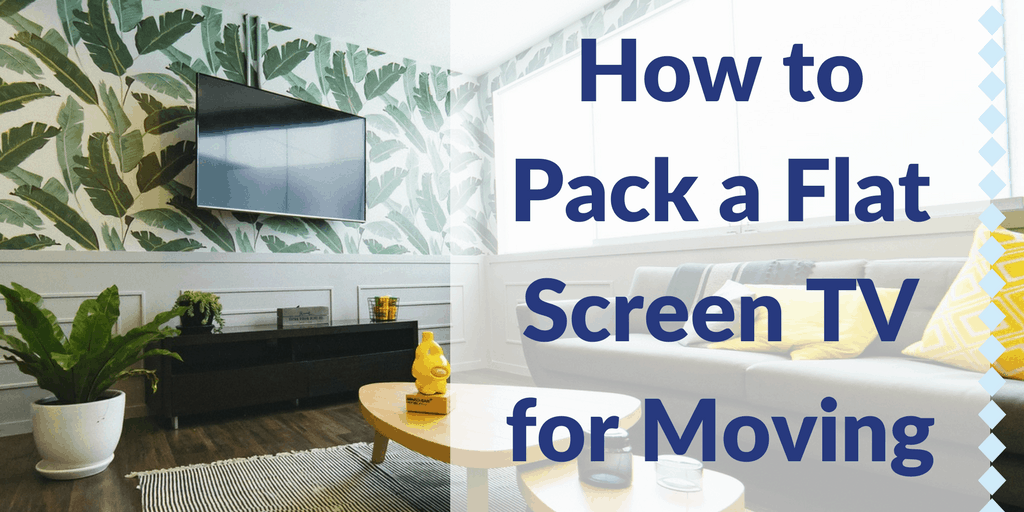How to Pack a Flat Screen TV for Moving
February 3, 2017
Around 35,000,000 flat screen TVs are sold annually in the US. Draw that out over 10 years, and that’s approximately one flat screen TV for every man, woman, and child (and infant) living in our great nation.
Flat screen TVs are great. They’re bigger and more energy-efficient than their older CRT counterparts, better for the environment, and the glow from the screen provides just the right amount of illumination to avoid stepping on Lego pieces in the dark.
All of this luxury comes at a price – and I’m not talking about the sales sticker.
At some point or other, you’re going to have to pack and move your flat screen TV to a new abode, and if you’re anything like me, damaging or destroying your flat screen TV is tantamount to losing a close relative.
I mean, not immediate family or anything. Maybe like a cousin, or a great-aunt that always slips a $50 into your palm at Christmastime.
Supplies you’ll need to pack your flat screen TV for a move:
- A sturdy moving box. It’s important to make sure the box is as well-fitted to the size of your TV as possible. The more room your flat screen TV has to move around inside the box, the more liable it is to get damaged. Any box of the right size will do, but the box your TV originally came in is always best.
- Two extra pieces of sturdy cardboard, cut just a little bit larger than the screen on your flat screen TV.
- 1 heavy-duty furniture pad. If you rented your own moving truck, they probably offered the use of a couple of these. If you didn’t take them up on it, you should have.
- Sheets of heavy-duty bubble wrap – enough to wrap the TV entirely, leaving no part exposed.
- “Dunnage” – shock absorbing material like foam wrap, crumpled packing paper or newsprint, or packing peanuts. Note: if you choose to use packing peanuts for dunnage, make sure that they are anti-static packing peanuts. Regular packing peanuts tend to generate quite a bit of static, which can sometimes shock or zap delicate electronics.
- 1 plastic baggie (ZipLock)
- Packing tape
- A permanent marker
Now it’s time to pack your flat screen for moving:
Next, if the power cord for the device can’t be detached, coil it at the back of the device and tape it there using masking tape. This is important so that the metal prongs from the power cord don’t scratch the sides or face of the device during transit.
Third, create a homemade screen protector. Take your two strips of sturdy cardboard and cut them so that they’re just about 1″ larger than the screen of your TV on all sides. Use packing tape to tape these two cardboard sheets together, and then cover both sides in bubble wrap.
Wrap the whole TV and homemade screen protector in bubble wrap. Make sure that nothing is exposed, especially the corners of the flat screen TV which are usually the most susceptible to damage.
Cover your bubble-wrapped flat screen TV with a furniture pad. As in the previous step, take great lengths to leave nothing exposed. Once you’re done, use packing tape to secure the loose end of the furniture pad.
Finish by gently sliding your flat screen TV into its box. Some flat screen TVs are more sensitive to this than others, but in any case it’s always a good idea to keep the TV upright (like it would be if you were watching it) the entire time, even when loading it into the box.
Mark the box with the following:
- Top: “FRAGILE” “ELECTRONICS” “THIS END UP” “LAST IN, FIRST OUT”
- All four sides: “FRAGILE” “ELECTRONICS” “LAST IN, FIRST OUT” (Optionally, add the room that these devices are supposed to go in.)
A few final pointers about moving your flat screen TV
1 Always keep a flat screen TV oriented upright, just like it would be if you were watching it.
2 Never load anything on top of your flat screen TV box. This seems like common sense, but you’d be surprised how often we see this happen when a customer has loaded their own moving truck. For the masses: Flat screen TVs, no matter how well they’re packed, are not load-bearing objects.
3 Try as hard as you can to find a space that’s just big enough for the box to fit into when you load your flat screen TV into your moving truck. The less opportunity the box has to move around, shift, or especially tilt/fall over (see #1 above), the better.











We Aim For 5 Star Service